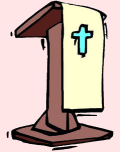Unique Crucifixion

Here is the 7th and final Lenten reading, centred around the Cross and Crown, kindly passed to us by Rev. David Linde *
On this Easter morning we come to the last symbolic cross in our Lenten season reflections. The familiar symbol before us is the cross encircled by the crown. What is the relationship between these two things? And why is Resurrection Sunday a fitting occasion to think on this?
The relationship between the cross and the crown was first displayed, we could say, at the crucifixion itself. That relationship was a poignant contrast: a Roman placard declaring that the bloody, writhing victim on this pole was the king of the Jews. That relationship provoked mockery: "If you are the king, come down from the cross!" To most eyes that day, the crucifixion site looked a lot like cross, and not much like crown.
Indeed, Jesus' crucifixion was only one of thousands carried out under Roman rule. And doubtless he was not the only crucified "criminal" who was despised and scorned by passers-by. How do we know that his crucifixion was unique, that it was all that we have been affirming in these Lenten season reflections - that it was a sacrificial death to pay the penalty for sin; that it was the meeting of divine justice and love; that it was the act that reconciled sinful man and holy God, bringing eternal life to all would believe?
One answer, of course, is that this is what the Bible teaches about his death. But on what basis did the biblical writers affirm it? The answer: Jesus' resurrection. It was Jesus' coming back from death - not just in spirit or in influence, but physically, bodily, objectively - that demonstrated and confirmed the uniqueness of his death. The resurrection showed that Jesus' death was neither routine nor tragic. No, the resurrection showed that his death was purposeful and had to do with the reversing of death itself. Therefore it had to do with the removal of the ultimate cause of death, namely, human sin. Paul the Apostle said that if Jesus had not been raised from death, we would still be in our sins (1 Cor. 15). But Jesus' resurrection shows that sin has met its just desserts. Its penalty has been paid. Paul declared that Jesus was delivered up to death because of our sins, and he was raised because of our justification (Rom. 4:25) - that is, he was raised because the work of the cross to bring about our right standing with God had been accomplished.
So the resurrection shows that the crucifixion of Jesus was unique. More broadly than this, the resurrection shows that Jesus himself is unique. The resurrection says something not only about his death; it says something about his identity. Paul wrote that Jesus was "declared with power to be the Son of God by his resurrection from the dead" (Rom. 1:4). And the New Testament shows that the emphasis of the early Christian message was on the resurrection and what it said about Jesus. It is summed up well by Peter in Acts 2:36 where he tells the crowds that the resurrection of Jesus, with his subsequent ascension to heaven, shows that he is both Lord and Christ.
This designation Christ brings us back to today's symbol. Christ means Messiah or anointed one. It is a term for the one specially appointed by God to be King. The resurrection shows that Jesus is the King. The placard on the cross, which seemed so pathetic at the time, told the truth: he is the King of the Jews, and not the Jews only, but the King of the whole world - the King of all who will embrace his reign.
Thus the resurrection interprets for us today's symbol. It confirms the cross; it confers the crown.
Today, on this side of his resurrection, we see how our King has fought for his people and won: it was through a cross. And we see what he has won for us: victory over sin and death. We ought never lose sight of the horrors of that bloody cross. We ought never lose sight of the supremacy of that crown. Our King bids us live - today and every day - at the foot of the cross, under the rule of the crown, in the life and power of the resurrection.
Let us pray:
Lord Jesus Christ, risen King, we worship you. We thank you for your cross, we rejoice in your resurrection, we embrace your rule. May your cross and your crown be the defining realities of our daily lives.
Amen.

